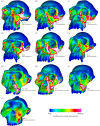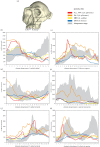Mechanical compensation in the evolution of the early hominin feeding apparatus
- PMID: 35703052
- PMCID: PMC9198777
- DOI: 10.1098/rspb.2022.0711
Mechanical compensation in the evolution of the early hominin feeding apparatus
Abstract
Australopiths, a group of hominins from the Plio-Pleistocene of Africa, are characterized by derived traits in their crania hypothesized to strengthen the facial skeleton against feeding loads and increase the efficiency of bite force production. The crania of robust australopiths are further thought to be stronger and more efficient than those of gracile australopiths. Results of prior mechanical analyses have been broadly consistent with this hypothesis, but here we show that the predictions of the hypothesis with respect to mechanical strength are not met: some gracile australopith crania are as strong as that of a robust australopith, and the strength of gracile australopith crania overlaps substantially with that of chimpanzee crania. We hypothesize that the evolution of cranial traits that increased the efficiency of bite force production in australopiths may have simultaneously weakened the face, leading to the compensatory evolution of additional traits that reinforced the facial skeleton. The evolution of facial form in early hominins can therefore be thought of as an interplay between the need to increase the efficiency of bite force production and the need to maintain the structural integrity of the face.
Keywords: australopith; diet; finiteelement analysis; ingestion; mastication.
Figures



References
-
- Rak Y. 1983. The ustralopithecine face. New York, NY: Academic Press.
-
- Prado FB, Freire AR, Rossi AC, Ledogar JA, Smith AL, Dechow PC, Strait DS, Voigt T, Ross CF. 2016. Review of in vivo bone strain studies and finite element models of the zygomatic complex in humans and non-human primates: implications for clinical research and practice. Anat. Rec. 299, 1753-1778. (10.1002/ar.23486) - DOI - PubMed
-
- Demes B, Creel N. 1988. Bite force, diet, and cranial morphology of fossil hominids. J. Hum. Evol. 17, 657-670. (10.1016/0047-2484(88)90023-1) - DOI
Publication types
MeSH terms
LinkOut - more resources
Full Text Sources
Miscellaneous
